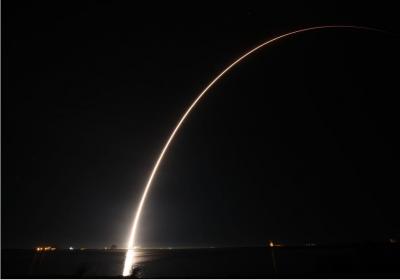Releases

BUCKLEY AIR FORCE BASE, Colo., Jan. 19, 2018 /PRNewswire/ -- The U.S. Air Force's 460th Space Wing is now "talking" with the fourth Space Based Infrared System (SBIRS) Geosynchronous Earth Orbit (GEO) satellite after its successful launch from Cape Canaveral Air Force Station, Florida, earlier this evening.
The Lockheed Martin (NYSE: LMT)-built SBIRS GEO Flight-4 satellite is responding to the Wing's commands as planned. Signal acquisition was confirmed approximately 37 minutes after the satellite's 7:48 p.m. EST launch aboard a United Launch Alliance (ULA) Atlas V rocket.
SBIRS GEO Flight-4 is the latest satellite to join the Air Force's orbiting missile warning constellation equipped with powerful scanning and staring infrared surveillance sensors. The sensors collect data for use by the U.S. military to detect missile launches, support ballistic missile defense, expand technical intelligence gathering and bolster situational awareness on the battlefield. The satellite also completes the initial constellation and allows SBIRS to provide global coverage.
Back on the ground at Buckley Air Force Base, a sophisticated new SBIRS ground control system – also designed by Lockheed Martin – serves as the nerve center for the entire SBIRS satellite constellation and receives large amounts of data from the satellites' powerful sensors. The SBIRS control system and its operators convert this data into actionable reports for defense, intelligence and civil applications.
"SBIRS is the nation's 24-7 global watchman, with infrared eyes ready to detect and deliver early warning and tracking of ballistic missiles. A cornerstone of the nation's missile defense system, SBIRS is proving even more precise and powerful than expected," said Tom McCormick, vice president of Lockheed Martin's Overhead Persistent Infrared systems mission area. "Space is a place to do great things, and we're already improving on SBIRS, upgrading our fifth and sixth SBIRS GEO satellites to our modernized LM 2100 satellite bus at no additional cost to the Air Force. On SBIRS 5 and 6 the Air Force saved $1 billion through improved production and management efficiencies."
In late 2016, Lockheed Martin also completed a major upgrade SBIRS' ground control system. The new "SBIRS Block 10" system includes enhancements like faster data collection times, improved threat detections, and improved target tracking and infrared information to enable troops to see dimmer targets faster. SBIRS Block 10 also provides the Air Force with greater efficiency by consolidating ground control for the legacy Defense Support Program, as well as SBIRS satellites and payloads in GEO and Highly Elliptical Orbits.
Next, SBIRS GEO Flight-4 will begin transitioning to its final location in geosynchronous orbit, approximately 22,000 miles above the Earth. There, the satellite's solar arrays, light shade and antennas will be deployed to begin on-orbit testing. The satellite will join SBIRS GEO Flights 1, 2 and 3, which were launched in 2011, 2013 and 2017 respectively and continue to meet or exceed performance expectations.
Lockheed Martin manufactured the SBIRS GEO Flight-4 satellite at its Sunnyvale, California, facility. The satellite was delivered to Florida on Oct. 31, 2017.
The SBIRS development team is led by the Remote Sensing Systems Directorate at the U.S. Air Force Space and Missile Systems Center, Los Angeles Air Force Base, California. Lockheed Martin Space, Sunnyvale, California, is the SBIRS prime contractor, with Northrop Grumman Aerospace Systems, Azusa, California, as the payload integrator.
For additional SBIRS information, photos and video visit: www.lockheedmartin.com/sbirs.
About Lockheed Martin
Headquartered in Bethesda, Maryland, Lockheed Martin is a global security and aerospace company that employs approximately 97,000 people worldwide and is principally engaged in the research, design, development, manufacture, integration and sustainment of advanced technology systems, products and services.
SOURCE Lockheed Martin

